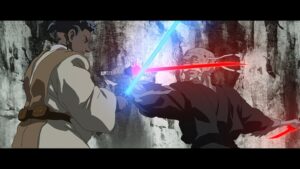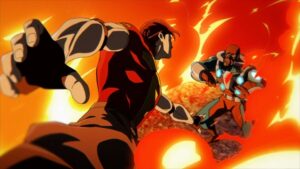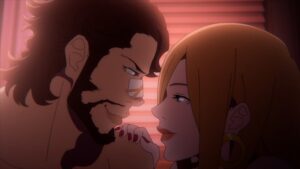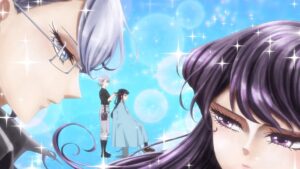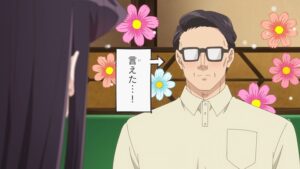Wooper: Another week, another solo appearance. I might as well retitle these posts “What’s Wooper Watching?” (Not a bad idea for a separate column, actually.) The three shows discussed below are getting regular coverage at this point; Stone Ocean would have been a great one-off addition, but I’m hopelessly behind on JoJo’s. I’ll surely throw in a few words about Aggretsuko’s fourth season when it drops in mid-December, so at least there’ll be something new to read in a week or two. See you then!
Star Wars: Visions – 7
“The Elder” is the second of Trigger’s two contributions to the Visions anthology project, as well as the driest of the seven I’ve seen thus far. Dry isn’t an adjective commonly applied to Trigger works, but it’s appropriate for the way this dialogue-heavy story was laid out. A drifting Jedi Master and Padawan sit in their spaceship for a while and discuss which planet they should explore next, eventually settling on an exceedingly gray and rocky one, which they explore for a bit. They stumble upon an old Sith, the last of his kind (an inversion of the light/dark balance in “The Ninth Jedi”), and have a brief lightsaber duel resulting in his death. And that’s it! Notice how the story opens on two men with no goal or destination in mind. They’re only motivated to visit a particular planet because one of them senses – you guessed it – a disturbance in the Force. Their Master/Padawan dynamic created a lot of opportunities for sagely sayings from the former, which seemed to be the aspect of the production most attractive to the director. Even after his opponent was defeated, he went right back into sage mode, talking about the inevitability of time and the proper mindset for strengthening oneself. I don’t mind a little philosophy in Star Wars stuff, since the Jedi are essentially a religious organization, but all ”The Elder” managed to depict here was a day in the life of a long-winded, lightsaber-wielding patrolman.
Super Crooks – 3-4
Now this is more like it. No more cafeteria conversations or tales of far-off antagonists – just one campy action sequence after another. The jewelry heist from last time led to a prolonged car chase in episode 3, which utilized our villainous quartet’s powers in flashy (if not necessarily creative) ways. It also leaned on bad CG for everything from characters to environments, but in fairness, the sort of city-wide havoc on display here couldn’t have been accomplished with traditional animation. As an apology, the show introduced an amusingly douchey superhero who could transform his body into a rubber ball at will, but was somehow not immune to Johnny’s electrical attacks. I can forgive that elemental oversight, though, because the follow-up was even dumber and cooler – enter The Praetorian, a hero with no control over which of his 200 powers (!) he uses. Last week I criticized Super Crooks’ animation for its stiffness, but episode 4 put that issue to bed, at least temporarily; Praetorian’s beatdown of Johnny & Co. looked great thanks to its versatility, jumping from fire breathing to airborne combat to good old fashioned body blows. The show’s method of neutralizing his character worked for me as well, since it established Johnny’s psychic girlfriend Kasey as much more than a sexpot, and foreshadowed her key role in the second arc. If the next two or three episodes are as good as these, I’ll be in for the long haul.
Komi-san wa, Komyushou desu – 6-7
I’m finally caught up with (the official subs of) Komi-san, and I’ve got to say this show is best taken one week at a time. Jamming episodes 6 and 7 together made both of them less distinct in my brain, despite the fact that they were narratively connected by a trip to the local outdoor pool. If the anime did anything unique with the “pool episode” concept here, it must have passed me by – lingering shots of girls in swimsuits, breath-holding contests, opportunities for close contact between teenagers, etc. are what I remember. While the show has largely gotten comfortable in the animation department, it did handle several shots of characters going down slides in plausible fashion, which by TV anime standards means it hit them out of the park. In between these slide scenes was perhaps my favorite moment of either episode, where Komi’s dad took her to a cafe and we learned that it was him, not his wife, from whom Komi inherited her extreme anxiety. Both communicate almost wordlessly, and both celebrate even the smallest of social successes, which made for some fun father/daughter scenes. Episode 6 is hardly worth a mention by comparison, though I continue to admire the way that the show creates crush-worthy moments between Tadano and Komi, then backs off once those moments have run their course. This strategy was most notable in the story about clothes shopping, which wouldn’t have been nearly as entertaining without Komi’s silent approval of the outfit Tadano picked for her. I’ve heard that manga readers lost their patience with that relationship ages ago, but the show’s light touch means I still find them cute.

